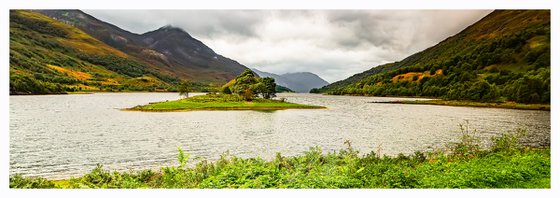- By medium
- By subject
- By budget
- Sales
- Gift cards
- Discover all art
- Artists
- Editors’ picks
- Ideas
Artwork description:
Picture this: the Pap of Glencoe rises majestically over Loch Leven in the Western Highlands of Scotland, where mountains embrace the water and clouds dance lazily overhead. This artwork reveals a tranquil island, cradled by shimmering waters and lush greenery that seems to hum with the whispers of nature. The gentle ripples reflect the soft hues of the sky, creating a dreamy atmosphere that invites you to take a deep breath and just... be.
I can almost hear the rustle of leaves and the distant call of birds. It’s like nature’s own symphony, and trust me, you’ll want to be part of it! This piece embodies the beauty of the great outdoors, perfect for those who appreciate a slice of tranquility in their space.
Hang it on your wall, and let it transport you to this peaceful haven every day. It’s not just art; it’s a little escape waiting to happen!
Known in Gaelic as Sgòrr na Cìche, the Pap of Glencoe is a familiar landmark around the lower end of the glen and Loch Leven. Despite its modest height, it is a sensational viewpoint and gives a short but steep and very rough hillwalk.
The Pap of Glencoe (Scottish Gaelic: Sgorr na Cìche) is a mountain on the northern side of Glen Coe, in the Highlands of Scotland. It lies at the western end of the Aonach Eagach ridge, directly above the point where the River Coe enters Loch Leven.
The Pap is so named as it has a distinctive conical shape resembling a female breast particularly when viewed from the west. It forms part of the "classic" view of the entrance to Glen Coe.
The simplest route of ascent starts from the unclassified road between Glencoe village and the Clachaig Inn. A pebble path leaves the road about 1 kilometre (5⁄8 mi) west of the youth hostel, and passes a white house on the left, reaching the bealach between the Pap and Sgor nam Fiannaidh, from where the Pap may be climbed.
The final stretch up to the bealach forms a pathway by small gully; this section is often extremely muddy and boggy. The final 100 metres (330 ft) of ascent require some easy scrambling, and care is needed under winter conditions.
The Pap may also be climbed from the Kinlochleven side, though this is far less common.
Psst!...there is also a framed version of this piece!
Materials used:
Baryta 310gsm Archival paper
Tags:
#scotland #mountains #valley #glencoe #picturesque #scottish highlands #panoramic #pap of #loch levan #kinlochlevanPap of Glencoe (2021) Photograph
by Michael McHugh
£90
- Photograph on Paper
- From a limited edition of 25
- Size: 59.4 x 21 x 0.01cm (unframed) / 56.4 x 18cm (actual image size)
- Signed and numbered certificate of authenticity
- Style: Photorealistic
- Subject: Landscapes, sea and sky
Loading
Artwork description
Picture this: the Pap of Glencoe rises majestically over Loch Leven in the Western Highlands of Scotland, where mountains embrace the water and clouds dance lazily overhead. This artwork reveals a tranquil island, cradled by shimmering waters and lush greenery that seems to hum with the whispers of nature. The gentle ripples reflect the soft hues of the sky, creating a dreamy atmosphere that invites you to take a deep breath and just... be.
I can almost hear the rustle of leaves and the distant call of birds. It’s like nature’s own symphony, and trust me, you’ll want to be part of it! This piece embodies the beauty of the great outdoors, perfect for those who appreciate a slice of tranquility in their space.
Hang it on your wall, and let it transport you to this peaceful haven every day. It’s not just art; it’s a little escape waiting to happen!
Known in Gaelic as Sgòrr na Cìche, the Pap of Glencoe is a familiar landmark around the lower end of the glen and Loch Leven. Despite its modest height, it is a sensational viewpoint and gives a short but steep and very rough hillwalk.
The Pap of Glencoe (Scottish Gaelic: Sgorr na Cìche) is a mountain on the northern side of Glen Coe, in the Highlands of Scotland. It lies at the western end of the Aonach Eagach ridge, directly above the point where the River Coe enters Loch Leven.
The Pap is so named as it has a distinctive conical shape resembling a female breast particularly when viewed from the west. It forms part of the "classic" view of the entrance to Glen Coe.
The simplest route of ascent starts from the unclassified road between Glencoe village and the Clachaig Inn. A pebble path leaves the road about 1 kilometre (5⁄8 mi) west of the youth hostel, and passes a white house on the left, reaching the bealach between the Pap and Sgor nam Fiannaidh, from where the Pap may be climbed.
The final stretch up to the bealach forms a pathway by small gully; this section is often extremely muddy and boggy. The final 100 metres (330 ft) of ascent require some easy scrambling, and care is needed under winter conditions.
The Pap may also be climbed from the Kinlochleven side, though this is far less common.
Psst!...there is also a framed version of this piece!
Materials used:
Baryta 310gsm Archival paper
Tags:
#scotland #mountains #valley #glencoe #picturesque #scottish highlands #panoramic #pap of #loch levan #kinlochlevan14 day money back guaranteeLearn more

